
Полная версия
Street Knowledge

STREET KNOWLEDGE
KING ADZ

For Kaiya & Casius - My Inspiration…
Table of Contents
Cover
Title Page
FOREWORD
BEGiN HERE…
A1ONE
AMSTERDAM
ASBESTOS
JONAS ÅKERLUND
ADVERTiSiNG
ALiFE
BANKSY
KELSEY BROOKES
NiNA BRAUN
BERLiN
BROKEN FiNGAZ
CENTRAL STATiON
MARTHA COOPER
CTRL
CULTURE JAMMiNG
C215
THE CiTY LOVES YOU
COHEN@MUSHON
JAMES DODD
ARAMiNTA DE CLERMONT
DJ CULTURE
DESiGNERS AGAiNST AiDS
DR D.
DOT DA GENiUS
CHOLE EARLY
EELUS
RON ENGLiSH
ENDTRODUCiNG: THE ART OF THE SAMPLE]
JOHN FEKNER
FiLTH MART
FAMiGiLA BAGLiONE
FiLM
FAVELA PAiNTiNG
FESTiVALS
JEROME ‘G’ DEMUTH
KATE GiBB
GRAFFiTi RESEARCH LAB
GRAFFiTi AND STREET ART: A BRiEF HiSTORY
RiCHARD GiLLiGAN
HiP HOP
MR. HARTNETT
HABBEHRATS
HUSH
HOUSE OF DiEHL
HARAJUKU STYLE/JAPAN
PAUL iNSECT
iSRAEL
iNTERiOR/EXTERiOR
iBiZA — THE BiRTHPLACE OF RAVE
JAMAiCA/REGGAE
TAMA JANOWiTZ
JEREMYViLLE
MR JAGO
KNOW HOPE
TONY KAYE
HUGO KAAGMAN
THE KLF
DAViD LACHAPELLE
MANDi LENNARD
THE LONDON POLiCE
LADY AiKO
LONDON
LOS ANGELES
LOMOGRAPGY
MiSS TiC
MiXTAPES
ALEX MAMACOS
CARRi MUNDEN
MELBOURNE
MADCHESTER
NO NEW ENEMiES
NEW YORK
123 KLAN
OBEY
100PROOF
ONiLi
PiLPELED
GUY PiTCHON
LEE ‘SCRATCH’ PERRY
PYMCA
JiM PHiLLiPS
QUiK
QUEENiE YEHENALA/SHANGHAi
QUEER CULTURE
RAPH RASHiD/BKTM
ROADSWORTH
ROME
RADiCAL CROSS STiTCH
SWOON
ViNCENT SKOGLUND
TiLLEKE SCHWARZ
SNEAKER FREAKERS
SOMEOTHERGUY
SHAWN STUSSY
STREET FOOD
THE SKATEBOARD
TOFER
TOMATO
OLiViERO TOSCANi
CANDiCE TRiPP
REGAN TAMANUi
UPPER PLAYGROUND
UNDiSCOVERED TALENT
URBAN EARTH!
URBAN SPORTS
UNDERGROUND
VHiLS
VEXTA
ViNYL TOYS & CHARACTER ART
ViDEO GAMES
iRViNE WELSH
WiLMA $
NiCK WALKER
GARTH WALKER
WiCKED STUFF TO CHECK
XENZ
YOUNGUNZ
YOUTH/SUB-CULTURES
YO! MTV RAPS
BENJAMiN ZEPHANiAH
ZEVS
ZBK
BONUS FEATURES
THANKS
CREDiTS
CREDiTS
Copyright
About the Publisher
FOREWORD
One thing I can certainly guarantee anyone buying this book is that with the possible exception of those of you who have read King Adz’s previous work, you’ll wait a long time before you see anything quite like Street Knowledge again. You’ll notice how lavish and vibrant both the text and illustrations are, and how comprehensive and off-the-wall the book is.
King Adz makes no distinction between so-called ‘high’ and ‘low’ culture, nor between the backgrounds of the diverse artists he includes in this work. Whether their point of exhibition happens to be in the corporate world - in terms of advertising campaigns or products produced by multinationals - or resolutely ‘underground’ - written on the walls and bridges of our urban environments - makes absolutely no difference to him. The only thing that matters is impact and visibility on the street. Adz defines street culture as ‘an ever-evolving influence on daily life. It can’t be held, but it can be seen, everywhere. It cannot be bought but it is often used to sell everything from video games to haute couture.
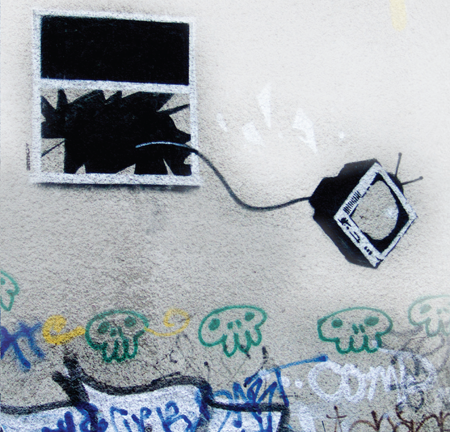
King Adz sees ‘street’ art purely in terms of its aesthetics and the impact it has on the people who experience it. So in Street Knowledge you’ll see a variety of art originating from right across the globe, culture depicted not only by fêted individuals who have become world-famous stars and consequently treated very well by capitalism, but also by resolutely subterranean figures who are little known outside a small group of perhaps largely local cognoscenti (and in many cases that’s exactly how they like it)-and just about everyone else in between.
Of course, the growth of the information highway and the continuing development of our cyberspace lives force us to consider the question of whether anything can truly be considered underground. As Adz says himself, ‘it’s 2010 and we’re all down with the latest everything. Nothing is hidden; everything is instantly accessible.
Art is created to be seen and enjoyed, debated and discussed. But while it can be accessed, it’s becoming an increasing myth that the Internet necessarily throws everything that’s good up into the light. For one thing, there’s just far too much going on for most of us to be able to care or spend the time sorting out the wheat from the chaff. In a disposable culture, we experience things in different ways. As for music, a young kid in the seventies and eighties might typically have bought a single every week and an album every month. These items were cherished artifacts, played time and time again, whose artwork and sleeve notes were poured over. Their counterparts in 2010 can immerse themselves in tracks from the 1930s or music that has been made literally minutes ago. And there is so much more of it made now.
This is where someone like King Adz comes in; he travels the world, checking out everything and everyone he’s heard of, been referred to, or stumbled across on the net. I personally rack up plenty of airmiles per annum, but I’m a positively stay-at-home, carpet-slippers individual compared to him. Look at the diversity of locations in this publication, he’s been to them all - from my home town of Leith where we took a leisurely stroll down the Walk to the Docks on a sunny day, enjoying the banter of some of the more colourful locals, to the Cape Flats of South Africa and beyond to the backstreets of Tehran. Evidence of his globetrotting is apparent throughout the book; Adz in your town, hanging out, taking in the visuals and the pulse of life.
If I was trying to get in touch with someone who didn’t want to be got in touch with, Adz would be the first person I’d go to, just in order to work out how to go about it. One of his great talents as an artist, compiler, networker and individual is his resolute refusal to see barriers where the rest of us have been conditioned into doing so.
Street Knowledge will turn you onto stuff that you would never ordinarily encounter in years of websurfing. I repeatedly found myself fascinated by stuff within its pages I’d hitherto had zero interest in, precisely because I had only had limited exposure. I tend to order books online these days. In some ways, this breaks my heart, because one of the great pleasures in my life used to be browsing in a bookstore, coming across something I didn’t expect to see. That pleasure is all but gone now, as when we walk inside it’s hard to escape the feeling we’re being force fed increasingly dull, corporate fare by marketing people, pushing us into sterile consumerist boxes: art, literature, travel, cooking, crime, romance, thrillers, classics. It’s therefore uplifting to come across something that intrinsically says, ‘fuck all that nonsense’.
So have some Street Knowledge.
Irvine Welsh
BEGiN HERE…
The images, sounds and flavours of the street have always been paramount to me. Ever since the age of eleven when I left the safety of a laid-back hippy-bippy Rudolf Steiner school and signed on at the local comp, I’ve been down with all things street. Okay so I had to deal with my first real taste of culture shock, but once I got to grips with the law of the jungle (or is that the law of the tumble?) and learned how to keep my head down at the same time as holding it high, it was a real eye-opener. I was hook, lined and sinkered. Soon, I became a Casual: Farrah slacks, Patrick trainers and Lacoste shirts were what went down, with my girlfriend (when I could get one) wearing ski-pants and an Ellesse jumper. I spent my time and money at the Haven Hotel Junior Disco each Sunday evening getting down to ‘Dr Beat’ and ‘White Lines’ (the Grandmaster Flash song - the drugs came later) and then I discovered Philip Salon’s Mud Club in Charing Cross Road and the world was my lobster. I’d get a train into town every Friday and queue up with the rest of the kids, but I soon got to know Philip and my eyes were truly opened to the club world. The music went from pop to go-go to hip hop and then to Balearic beats, and it wasn’t long before I went to the legendary Central Saint Martin’s College of Art and Design and became one of the resident artists at the Brain Club, the most happening, creative club in London at the end of the eighties.

I am an urbanist. Okay, so I’m from the green suburbs of London but that is just the point. It’s not about where you are from it’s about what you are in to. They call it ‘crate-digging’ (a reference to record buyers going through crates of vinyl), as we are all about what we choose to take from the many influences and references that circle in the cultural ether like a 747 in the stack above LHR. And it’s about what we choose to adopt as our own, to appropriate, just like the rise of the art of sampling (other people’s records). Some people said that it wasn’t music, but to me it was something that changed my life. DJ Shadow, DJ Cam, The KLF. Say no more. Most probably the same fuckers who said the Hip Hop was just a craze, that it would pass.
We are well into the twenty-first century and we’re all down with the latest in everything. Nothing is hidden, everything is instantly accessible. Urban street culture has influenced everything you can touch, see, smell, watch, buy, wear, listen to, download, upload, TIVO, record and burn. The concept of this book is to document the influences on urban culture over the last 30 years and chart its progression from its origins to where it is today; to pay respect and give the biggest props to those people, places, social situations, music, films and images that have made a difference and helped shape the ever-changing look and feel of the movement. And to look to where it is going.
What is street culture? It is an unconscious creative collective (in the fields of art, food, music, fashion etc) that is borne from the streets of the urban environment. It has its own visual language: a multi-ethnic, multi-disciplined, multi-media, stream of consciousness that has a unique look and feel which cannot be faked. The audio/visual is god in street knowledge. As is frequently suggested, sound and image is (almost) everything, and it is an integral part of its DNA. This visual language is an ever-changing montage of retro and futuristic images. The cyclic nature of the culture means that looking back is just as important as looking forward. But to see the future you’ve got to know the past.
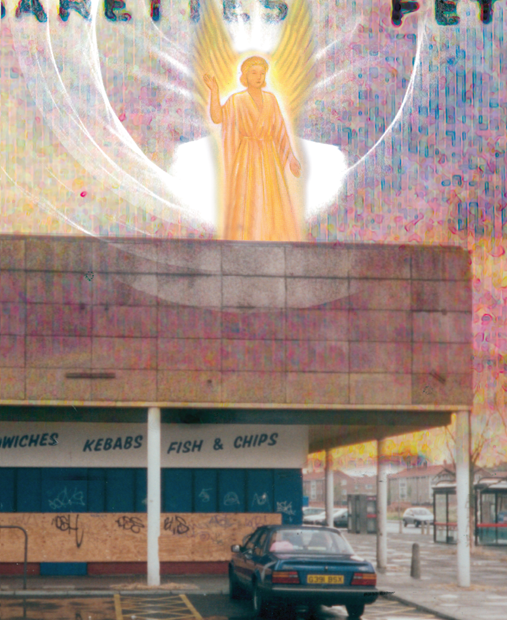
TOOLS OF THE TRADE
To create this book I used a Canon G10 Camera, a 24-inch iMac, a Sony HC9-HDV camcorder, a notebook and a pen. I flew around the world thrice times and had the I honour of getting down with many of my heroes and a lot of seriously talented and seriously generous human beings. The reason why I’m telling you this shit is that part of my M.O. is that knowledge should be shared and not hidden. There is no secret to what I do: I’ve just worked hard for years to get to this point. Okay, so you need to be able to write and have respect for your gut feelings when you see something good, and to be interested in street culture and the world and people around you. Like the man said, you have to work hard and be nice to people.
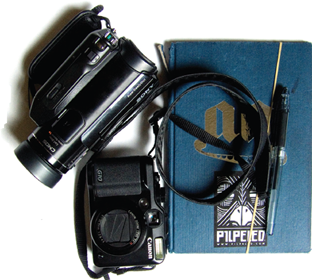
HOT SPOTS
One of the philosophies I want to spread with this book is to turn people on to new and unknown experiences, so at the end of each city entry there is a ‘Hot Spots’ list and at the back of the book you’ll find a list of reference points, further reading or viewings to use as a starting point when planning your own adventure, on or off line. Once you’re out there you will find out that these lists are just the tip of the iceberg and the real adventure is totally one of your own creation. This is the best kind of voyage: one you and no one else owns.
Please remember that this book is just my personal view of the world of street life and obviously I can’t write about everyone who has ever had an effect on the culture, so there are going to be some people, events and happenings that I’ve not covered. I’ve tried to document the epic journey I have taken in the last 25 years of my life to present the past, present and future of street culture, looking at street art, music, fashion, film, design, the media, photography, craft, retail, street food, spots to hang out in the coolest cities, websites, events, subcultures and movements etc.
All massive hear me now! Hold tight!
Peace+Love

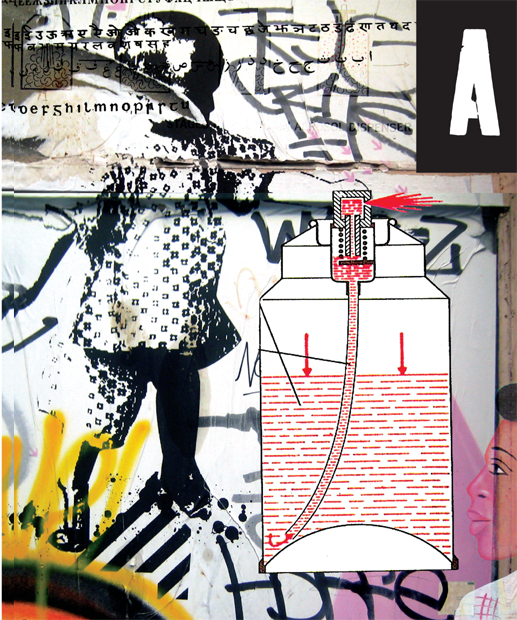
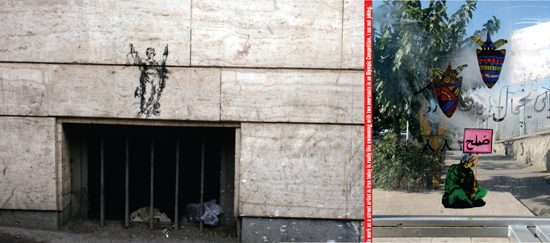
A1ONE
www.kolahstudio.com
When it comes to Iran, there’s only one real street artist who is worth mentioning at the moment and that is Alone. He has been holding it down for many years on his own with no community support and is the most hardworking and dedicated street artist in Iran. In the west we know nothing about oppression and have been getting up (the process of putting up illegal art in the street) for as long as Alone has been living under an oppressive, watchful regime, something truly remarkable indeed. People disappear for much less and in 2007 Alone staged the first-ever stencil art exhibition in Tehran. Which says a lot about how he operates — the fact that he was the only person to stick his neck out and put on an exhibition dedicated to an outlawed art form. I have been friends with Alone for some years now and have seen him develop an original style: he started out just using stencils and now has allowed his work to be influenced by folk art and contemporary painting. I asked him who his influences are.
‘My work has been influenced by Van Gogh, Francis Bacon, Nietzsche, music, Blek le Rat, Logan Hicks, Jeff Soto…’

It is when I ask about his goals that I begin to underderstand about life in Iran.
‘Goals? Me? I really enjoy painting and finding more things from the act of painting and forgetting my urban self. To live and feel that I am ALIVE. In my social life I am trying to learn what I need and give what I have when I’m painting. I have many goals for my future and life but when I am at the desk I feel like I have no goals.’
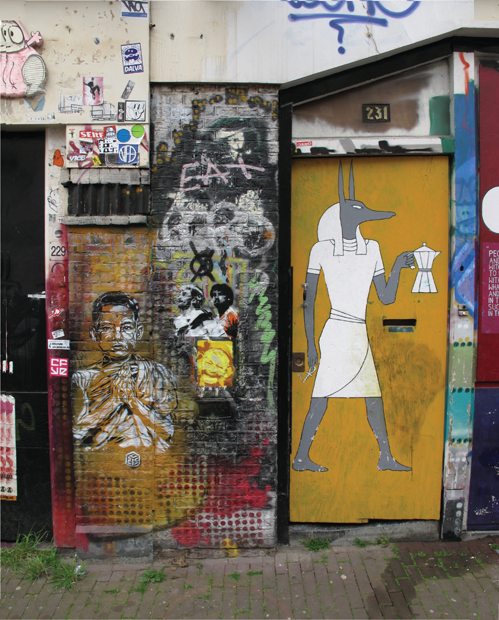
AMSTERDAM
This is the old pirate island where back inna day you could buy anything you wanted and anything went. It has changed a bit in the last 20 years but there is still something for everyone in the city of madness. I always liken it to an adult Disneyland: a place chock-full of adult rides (sex and drugs) and fantastic sights and parades (check out Queen’s Day on 1 April for complete mayhem). The Dutch are a creative lot and Amsterdam is where the best of them congregate to get it on. They love their street art, stickers, good food, football, drinking, legal and illegal drugs, galleries, clubs and advertising. They aren’t hung up about much and so this leads to a free-and-easy atmosphere.
But that said, Amsterdam is changing slowly from an open-air adult-orientated museum into a city of pure creativity. For a while, the city’s inspirational talents were jumping ship in favour of Rotterdam, but that is now over. The tourists are still arriving in droves but they seem to be contained to one or two areas of the ’Dam, namely the red light district and the coffee shops. These tourist areas are in the east and the south central area of the city. Just a few hundred feet east of the Centraal Station you’ll find the Warmoesstraat, the beginning of the red light and coffee shop area, in which to lose your mind. The sex and spliff aspect of the ’Dam has to be experienced before you can make up your mind about whether it’s cool or not. I’ve spent many trips to the ’Dam getting wasted back inna day and stumbling around the red light district, but these days I’m straight and the place still rocks. Remember that all the guys selling drugs on the street are just trying to rip you off. Okay, the first thing you gotta know is that all hard drugs are illegal, but if you’re determined to buy drugs then stick to the coffee shops. If you want something that isn’t on the menu then ask the dealers in the coffee shop if they have any info. There is a heavy heritage of culture within the city and all aspects of creativity are respected and encouraged. There are some killer advertising agencies here now (>p104) and the fashion and arts industries are gathering momentum.
If you go off the tourist route slightly you will find the real Amsterdam — a clean, civilized place, almost the opposite to the red light district.
Around the Spui (a square slap-bang in the centre of the ’Dam) is the place to be for book lovers, as there’s a ton of bookshops and a weekly book market on Fridays. There are some great places to eat and traditional style bars in which to spend the evening. Which is exactly where I was when I last hooked up with Michel van Rijn.
Amsterdam is home to my old pal Michel — one of the world’s last true adventurers: art expert, stolen antiquities hunter, multi-millionaire playboy. He’s a larger-than-life character with a heart of gold, and I’m truly happy to see him whenever I go to the ’Dam. We always mooch off to a pavement bar where Michel begins to tackle a long line of double bloody Marys without any visible effect. He then fills me in on his latest accomplishments, none of which I can speak about, let alone write about here. Let’s just say that he’s got his fingers in a lot of pies and one of the biggest and most complete collections of religious art in the world. A true bon viveur!
HOT SPOTS
Best homemade fries in town: Vleminckx, Voetboogstraat
Wicked bookshop: The American Book Centre, Spui 12
Great ‘hood: De Pijp, take tram 16 or 24 or 25 to Albert Cyperstr then walk east
Good Bar: Café ‘t Spui-tje, Spuistraat 318 (old-school ’Dam bar)
Great Hotel: The Lloyd Hotel. Oostelijke
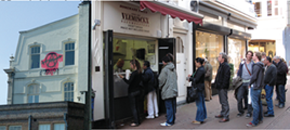
ASBESTOS
www.theartofasbestos.com
A few years ago I bumped into Asbestos while he was busy rubbing down one of his large-scale pieces of someone’s hand on somebody else’s wall in a suburb of Antwerp. I know his work but had never met the guy so I stopped to talk. It’s at moments like this that you know you’re gonna get on with someone and me and Asbestos click like a clockwork orange and that is it: Down for life, and so we hang out for a weekend doing the ‘street-art shuffle’ and generally getting down with some serious hang time and talk shop.
‘My art is defined by the people I meet and interpreting them, it’s about the human form and the environment that I live in’ he says. ‘I like to interact with the space that’s around me and the streets are ripe with opportunities to express yourself. Whether it’s a painting I’ve put up on a wall or a sticker on a lamppost, it all adds to the layers of dirt and personality of a city. My paintings are meant to become part of their environment and the longer they stay up, the more they blend in and integrate with the walls. Hopefully the odd passer-by will see the work and react to it. Positive or negative, any response is good for me — once work is out on the street it’s fair game to be loved or criticized, I release all control of it once I put it out there.’
What I like about Asbestos’ work is that his gallery pieces are all created on discarded material found in the streets, usually around where the show is taking place.
‘All my work is done on found objects, be it wood, plasterboard, metal or anything else I notice in a skip at 3 am. These objects have a history and a personality to them that cannot be faked. They’re a snapshot of the past and part of the fabric of the city which missed their chance of a quiet life in a landfill site.’
His art has evolved in a natural way. He has never jumped on any bandwagon or followed any trends in art whatsoever.
‘In the last year my work has been inspired by the use of the triangle and deconstructionist shapes that I’ve seen in architectural structures. The triangle has now become a central element in my work that ties together the dirty, random, found aesthetic that I’ve always loved with a hard and structured form of the triangle. Thinking about the triangle, I’ve come to realize it’s the coolest of all the shapes — circles and squares have nothing on it.’


